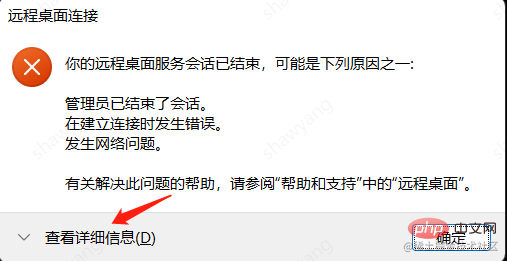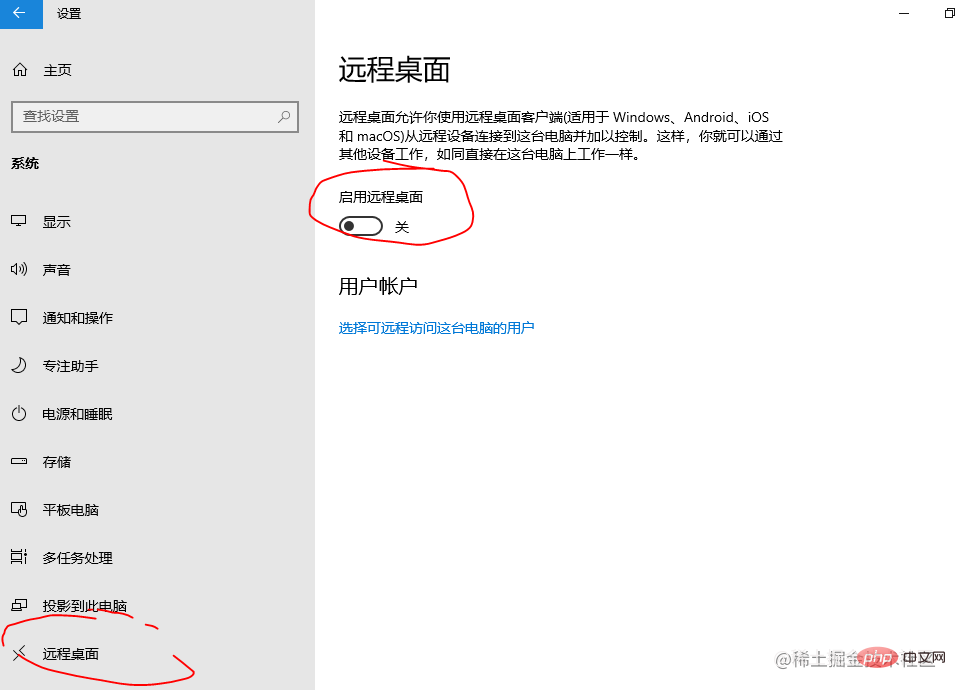 Topics
Topics
 Pagoda Panel
Pagoda Panel
 A brief analysis of the problem that the server cannot be remote after installing Pagoda
A brief analysis of the problem that the server cannot be remote after installing Pagoda
A brief analysis of the problem that the server cannot be remote after installing Pagoda
This article is introduced by the tutorial column of Pagoda Panel about the problem that server2022 cannot be remote after installing Pagoda. I wonder if you have encountered such a problem? Let me show you how I handle it!
server2022 Can’t be remote after installing Pagoda?
server2022 installation pagoda will not work remotely.

Check the detailed information and it is Error code: 0x3 Extended error code: 0x11
Your Remote Desktop Services session has ended, possibly for one of the following reasons: The administrator has ended the session. An error occurred while the connection was being established. A network problem occurred.For help solving the problem, see "Remote Desktop" in Help and Support. [Expanded Information]Error code: 0x3 Extended error code: 0x11
The above are screenshots of the error report in Chinese and English versions
In addition, not only the remote error is reported, the remote monitoring inside the machine is normal, and the remote desktop services are running, but compared with the normal system, this place is not lit. , it can’t light up after trying many times

Other netizens on the Internet also reported this remote problem, but none of the solutions provided were reliable.
We have confirmed with Microsoft and Baota that it was caused by Baota deleting the permissions of the users group in the root directory of drive C. Baota’s official website wrote that it is not recommended to use Baota in 2022. They have not internally tested the use of Baota in 2022.


#If you continue to use it, you can add users permission to the root directory of C drive and restart the remote service recovery.
The underlying principle is this:
There is a process of RDPiDD (RDP indirect display) remotely. This process C:\Windows\System32\WUDFHost.exe will call C:\ Windows\System32\drivers\UMDF\RDPidd.dll
WUDFHost.exe requires users group permissions or local service user permissions. According to actual tests, remote restoration can also be achieved by adding local service user permissions alone, but due to C The lack of users group permissions in the drive root directory has a greater impact. The C drive root directory has users group permissions by default. It is recommended to restore the users group permissions.
Bloggers use 3A servers, which have low latency and high security. Generally speaking, they are the most cost-effective on the market.
The above is the detailed content of A brief analysis of the problem that the server cannot be remote after installing Pagoda. For more information, please follow other related articles on the PHP Chinese website!

Hot AI Tools

Undresser.AI Undress
AI-powered app for creating realistic nude photos

AI Clothes Remover
Online AI tool for removing clothes from photos.

Undress AI Tool
Undress images for free

Clothoff.io
AI clothes remover

Video Face Swap
Swap faces in any video effortlessly with our completely free AI face swap tool!

Hot Article

Hot Tools

Notepad++7.3.1
Easy-to-use and free code editor

SublimeText3 Chinese version
Chinese version, very easy to use

Zend Studio 13.0.1
Powerful PHP integrated development environment

Dreamweaver CS6
Visual web development tools

SublimeText3 Mac version
God-level code editing software (SublimeText3)

Hot Topics
 1663
1663
 14
14
 1420
1420
 52
52
 1313
1313
 25
25
 1266
1266
 29
29
 1239
1239
 24
24
 How to set the speed limit of the virtual host through the Pagoda panel
Jun 21, 2023 am 11:17 AM
How to set the speed limit of the virtual host through the Pagoda panel
Jun 21, 2023 am 11:17 AM
Pagoda Panel is a very excellent server management panel under Linux system. It has powerful functions and friendly interface, which can help users manage servers easily. In the process of using the Pagoda Panel, it is sometimes necessary to limit the speed of the virtual host to ensure the stability and fluency of the server. This article will introduce how to set the speed limit of the virtual host through the Pagoda panel to achieve a good user experience. 1. Overview of Speed Limit Speed limit refers to limiting the host bandwidth and ensuring the normal operation of the server by controlling the host traffic. exist
 Introduction to the WebDAV file management function of Pagoda Panel
Jun 21, 2023 am 11:33 AM
Introduction to the WebDAV file management function of Pagoda Panel
Jun 21, 2023 am 11:33 AM
Introduction to the WebDAV file management function of Pagoda Panel WebDAV is a file management technology based on the HTTP protocol. It allows users to access files on the network through the HTTP protocol and manage these files. With the support of WebDAV technology, we can build a Web server to provide various network services. Pagoda Panel is a popular web server management tool that provides a wealth of functional modules, among which the WebDAV file management function is one of them. Below, this article
 How to use the Pagoda panel to set up domain name resolution
Jun 21, 2023 am 09:19 AM
How to use the Pagoda panel to set up domain name resolution
Jun 21, 2023 am 09:19 AM
With the development and popularization of the Internet, domain names have become an indispensable part of our online world. However, many people are still confused about the settings of domain name resolution. Today, we will introduce how to use the Pagoda panel to set up domain name resolution. What is DNS? Domain name resolution is the process of binding a domain name to the IP address of the website or server it represents. It is a process that converts human-readable domain names into computer-readable IP addresses. The main components of domain name resolution are: domain name registration, DNS resolution and we
 How to use Pagoda Panel for MySQL management
Jun 21, 2023 am 09:44 AM
How to use Pagoda Panel for MySQL management
Jun 21, 2023 am 09:44 AM
Pagoda Panel is a powerful panel software that can help us quickly deploy, manage and monitor servers, especially small businesses or individual users who often need to build websites, database management and server maintenance. Among these tasks, MySQL database management is an important job in many cases. So how to use the Pagoda panel for MySQL management? Next, we will introduce it step by step. Step 1: Install Pagoda Panel. Before starting to use Pagoda Panel for MySQL management, you first need to install Pagoda Panel.
 How to use Pagoda Panel for reverse proxy cache configuration
Jun 21, 2023 pm 01:06 PM
How to use Pagoda Panel for reverse proxy cache configuration
Jun 21, 2023 pm 01:06 PM
With the continuous development of the Internet, the number of visits to the website is increasing, which also puts forward higher requirements for the performance of the website. Reverse proxy caching can improve the access speed of the website, reduce the load on the server, and provide users with a better access experience. This article will introduce how to use the Pagoda panel for reverse proxy cache configuration. 1. What is reverse proxy cache? Reverse proxy cache refers to adding a reverse proxy server between the server and the client. When the client initiates a request to the server, the request is not sent directly to the server, but is first sent to the reverse proxy server. To the agent
 How to use Pagoda Panel for website repair and maintenance
Jun 21, 2023 pm 03:19 PM
How to use Pagoda Panel for website repair and maintenance
Jun 21, 2023 pm 03:19 PM
In the current Internet era, websites have become an important means for many companies to display and promote themselves. However, it is inevitable that some unexpected situations will cause the website to be inaccessible or have limited functions. At this time, the website needs to be repaired and maintained. This article will introduce how to use Pagoda Panel for website repair and maintenance. 1. Introduction to Pagoda Panel Pagoda Panel is a website management software running on a Linux server. It can help users quickly build a Web environment on the server operating system. The Pagoda panel integrates numerous functional modules
 What is a pagoda panel? how to use?
Jun 21, 2023 pm 11:21 PM
What is a pagoda panel? how to use?
Jun 21, 2023 pm 11:21 PM
What is a pagoda panel? how to use? With the rapid development of Internet technology, many website managers and developers are faced with the problem of how to manage their servers and websites quickly and conveniently. For this reason, batches of server management tools have emerged. The Pagoda Panel is one of the most popular server management tools. This article will introduce what the Pagoda Panel is and how to use it. 1. What is a pagoda panel? Pagoda Panel is a server management tool based on Linux operating system. It provides some commonly used server management
 How to configure UFW firewall through Pagoda panel
Jun 21, 2023 am 09:08 AM
How to configure UFW firewall through Pagoda panel
Jun 21, 2023 am 09:08 AM
Configuring a firewall on a Linux server is very important, as it can effectively protect the server from malicious attacks. On the Ubuntu operating system, we can use UFW firewall to protect the security of the server. In this article, we will introduce how to configure UFW firewall using Pagoda panel. Step 1: Install Pagoda Panel First, we need to install Pagoda Panel on Ubuntu. You can download the installation package of Pagoda Panel for free from the Pagoda official website, and then run the following command in the command line to install Pagoda Panel: $wget



